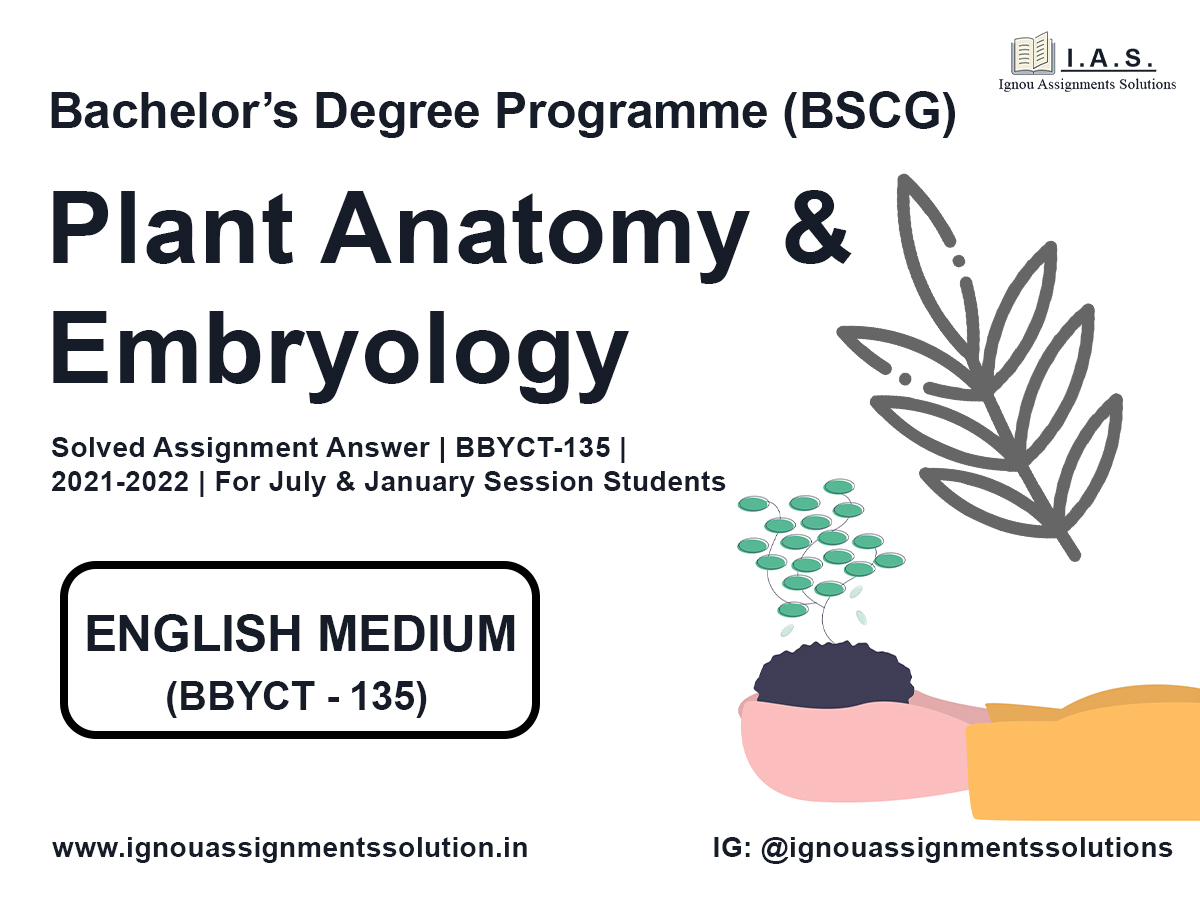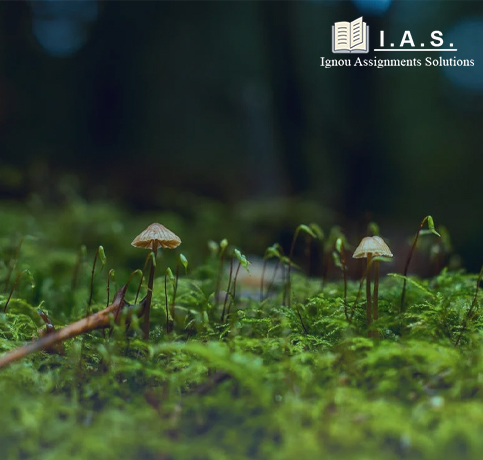IGNOU Assignments Solutions | Ignou Question Paper & Updates
Bachelor’s Degree Programme (BSCG) – COMPARATIVE ANATOMY & DEVELOPMENTAL BIOLOGY Solved Assignment Answer | BZYCT 133 | 2021-2022

Free BZYCT 133 Solved Assignment Answer | COMPARATIVE ANATOMY AND DEVELOPMENTAL BIOLOGY OF VERTEBRATES| For July 2021 – June 2022
IGNOU BZYCT 133 Solved Assignment, This assignment is the curriculum of the BACHELOR’S OF SCIENCE (BSCG) program. For other courses, students check our website categories section to find their courses and assignments over there.
BZYCT-133 COMPARATIVE ANATOMY AND DEVELOPMENTAL BIOLOGY OF VERTEBRATES Solved Assignment 2021-2022
IGNOU BZYCT-133 COMPARATIVE ANATOMY AND DEVELOPMENTAL BIOLOGY OF VERTEBRATES assignment is 100 marks. There are two sections – A and B. Students have to answer all the questions. Download IGNOU BZYCT-133 Assignment free without any registration, Students can easily download the IGNOU assignment question paper from the official website of the university. They are not required to pay any fees or charges for this.
| Title Name | BZYCT-133 Solved Assignment 2021-2022 | COMPARATIVE ANATOMY AND DEVELOPMENTAL BIOLOGY OF VERTEBRATES |
| University | IGNOU |
| Service Type | Solved Assignment (Soft Copy/Q&A form) |
| Course | BSCG |
| Language | English |
| Semester | Session: July 2021 – January 2022 |
| Short Name | BZYCT-133 |
| Assignment Code | BZYCT-133/TMA/January 2022 |
| Product | Assignment of BZYCT-133 | 2021-2022 |
| Submission Date | Valid from 1st July 2021 to 30th June 2022 |
| Assignment Pdf | Download Now |
How to get COMPARATIVE ANATOMY AND DEVELOPMENTAL BIOLOGY OF VERTEBRATES, BZYCT 133 Solved Assignment?
It is always good to solve the assignment by yourself. Because it helps the students in the whole study. It also helps them in preparing for the exam. So that the question that comes in the exam can be solved easily.
If someone is unable to solve the assignment, so don’t worry we have solved this assignment for you, you only need to click the link one by one and get all the answers to this assignment sequence-wise. And if not, then our team is working on it and you will be available soon.
The answer of BZYCT-133 | COMPARATIVE ANATOMY AND DEVELOPMENTAL BIOLOGY OF VERTEBRATES | Solved Assignment 2021-2022:
Note: Attempt all questions. The marks for each question are indicated against it.
Part – A
1. i) Match the following:
i) Femoral glands a) Birds
ii) Uropygial glands b) Crocodiles
iii) Scent glands c) Lizards
iv) Mammary glands d) Eye lids of mammals
v) Meibomian glands e) Female mammals
vi) Sebaceous glands f) Mammals
ii) Give five features that you can use to distinguish between the skulls of frog and rabbit.
2. a) Describe the specializations found in ruminant stomachs.
b) What are the peculiar features of the respiratory system of agnathans?
3. a) Give short answers to the following:
i) What is the major modification that occurs in reptilian aortic arches?
ii) What is the role of ductus arteriosus in a bird’s circulatory system?
iii) How does the right subclavian develop in mammals?
iv) Write one difference between somatic and visceral arteries.
v) What are precaval veins?
b) Write short notes on:
i) Kidney blood circulation
ii) Types of mammalian uteri
4. i) Fill in the blanks:
a) In fishes the …………………. covers the brain and spinal cord.
b) Reptiles and birds have a double membrane made up of …………… and …………………. to protect the brain.
c) In lower vertebrates the epithalamus forms …………………. and …………………. .
ii) How do bats prevent getting deaf from their high-frequency calls? How do they get information about the immediate environment?
5. Briefly write the functions of the following hormones secreted in mammals.
a) Adrenocoricotropic hormone
b) Parathormone
c) Aldosterone
d) Testosterone
e) Progesterone
Part – B
6. List at least three stages in gene expression that can be regulated to result in differentiated cell types? Explain any one of them with the help of an example.
7. i) a) How would you define a ligand in cell-to-cell signaling?
b) What is the difference between juxtacrine and paracrine signaling.
c) How is EMT used in the embryo and in the adult?
ii) What is a signal transduction pathway? Write out its steps in the order they would occur in a target cell.
8. i) Chose the correct answer from the alternatives provided.
a) Fertilization is responsible for the activation/arrest of development.
b) Activation of the sperm ensures/does not ensure that sperm will meet the egg.
c) In organisms with external/internal fertilization, chemotactic mechanisms have been evolved to attract the sperm towards the egg.
d) A period of maturation in the female reproductive tract required for the transformation of sperm is known as activation/capacitation.
e) Sperm using an enzyme called acrosin/hyaluronidase penetrate their way through zona pellucida.
ii) Fill in the blanks with suitable words.
a) ………………. is the extension of egg cytoplasm around the entering sperm head.
b) Inhibitor of microfilament formation such as ……………… prevents the formation of fertilization cone.
c) The early response for the entry of sperm into the egg is the prevention of ………………. .
d) The ………………. for polyspermy is mediated by the electrical depolarization of the egg plasma membrane.
e) The slow block to polyspermy is achieved by …………… reaction.
9. i) Indicate the following changes that occur during metamorphosis in amphibians either as progressive or regressive or remodeling:
a) The development of the middle ear in connection with the pharyngeal pouch.
b) The change in the shape of the mouth and the shortening and reduction of the cloacal tube.
c) Disappearance of lateral line organs of skin and reduction of blood vessels.
d) The differentiation of the brain.
e) The changes in the portal system and the changes in the vascular system to supply blood to the lungs.
ii) Name the organs derived from:
a) Dorsal mesoderm
b) Lateral plate mesoderm
10. i) What is the function of amniotic fluid? How are substances exchanged between the embryonic and maternal blood?
ii) Which common maternal diseases can lead to flaws in development? Explain.
Wrapped Up
- For More BSCG Assignments – BSCG Solved Assignment
- For Hand Written Assignments – Click here
For more Updates join our Telegram Group and also for your inquiry you may comment here or mail us –info@ignouassignmentssolutions.in
Telegram Group – Click Here
- bzyct 133 solved assignment
- ignou assignment 2020
- ignou assignment 2021
- ignou assignments
- ignou solved assignment
- ignouassignmentstatus
| M | T | W | T | F | S | S |
|---|---|---|---|---|---|---|
| 1 | 2 | 3 | 4 | 5 | ||
| 6 | 7 | 8 | 9 | 10 | 11 | 12 |
| 13 | 14 | 15 | 16 | 17 | 18 | 19 |
| 20 | 21 | 22 | 23 | 24 | 25 | 26 |
| 27 | 28 | 29 | 30 | 31 | ||
Recent Posts
- IGNOU Hall Ticket June 2023 – Check TEE June 2023 Admit Card Ignou
- IGNOU BHIC 104 Previous Year Question Paper & Important Question | Arts (Honours) Ignou Question Paper
- IGNOU BHIC 103 Previous Year Question Paper & Important Question | Arts (Honours) Ignou Question Paper
- IGNOU BHIC 102 Previous Year Question Paper & Important Question | Arts (Honours) Ignou Question Paper
- IGNOU BHIC 101 Previous Year Question Paper & Important Question | Arts (Honours) Ignou Question Paper
Recent Comments
Top Categories
Sign Up to Our Newsletter!!!

IGNOU BPAC 132 Previous Year Question Paper & Important Question | I.A.S.

Master's Degree Programme (MCA) - Data Science and Big Data Solved Assignment Answer | MCS 226 | 2021-2022

What is meant by Industry & Industrial dispute? What are the authorities under the Act and the duties entrusted to them?

IGNOU BBYET 143 Previous Year Question Paper & Important Question | Botany Ignou Question Paper

IGNOU BHIC 102 Previous Year Question Paper & Important Question | Arts (Honours) Ignou Question Paper

Bachelor’s Degree Programme (BSCG) - Plant Anatomy and Embryology Solved Assignment Answer | BBYCT 135 | 2021-2022

Master's Degree Programme (MBA) - E-Governance Solved Assignment Answer | MPA 017 | 2021-2022

Master's Degree Programme (MSW-C) - Relevance of Social Case Work in Counselling Solved Assignment Answer | MSW-014 | 2021-2022

Bachelor’s Degree Programme (BSCG) - COMPARATIVE ANATOMY & DEVELOPMENTAL BIOLOGY Solved Assignment Answer | BZYCT 133 | 2021-2022

IGNOU BZYCT 137 Previous Year Question Paper & Important Question | I.A.S.

Bachelor of Art General & Honours (BAG) - English Language Teaching Solved Assignment Answer | BEGS 185 | 2022-2023

Bachelor of Art General & Honours (BAG) - Business Communication Solved Assignment Answer | BEGS 186 | 2022-2023

Bachelor of Art General & Honours (BAG) - English Communication Skills Solved Assignment Answer | BEGAE 182 | 2022-2023

Master's Degree Programme (MSW-C) - Fields of Counselling Solved Assignment Answer | MSW-016 | 2021-2022

IGNOU ECO 06 Previous Year Question Paper & Important Question | Commerce Ignou Question Paper

IGNOU ECO 05 Previous Year Question Paper & Important Question | Commerce Ignou Question Paper

IGNOU ECO 03 Previous Year Question Paper & Important Question | Commerce Ignou Question Paper






